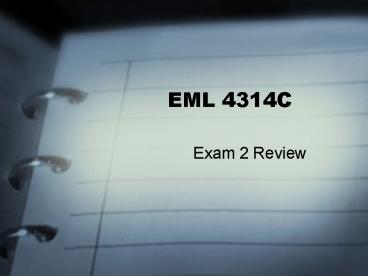EML 4314C - PowerPoint PPT Presentation
1 / 16
Title:
EML 4314C
Description:
Lab 7: Synthesizing controller gains to meet system performance ... Add a derivative control to improve the overshoot ... OVERSHOOT. RISE TIME. CL RESPONSE ... – PowerPoint PPT presentation
Number of Views:74
Avg rating:3.0/5.0
Title: EML 4314C
1
EML 4314C
- Exam 2 Review
2
Topics
- PID Tuning
- Lab 7 Synthesizing controller gains to meet
system performance specifications (e.g., OS,
steady-state error, stable, ) - Ziegler-Nichols (Z-N)
- Pole Placement
- Parameter Identification
- Lab 5 From set of system responses determined m,
k, c, z, ?n, ?d and L01 - Logarithmic decrement
3
PID Tuning
- Effects of P, I, D and velocity feedback on
system response and the error - Design procedure
- General approach
- Ziegler Nichols (Z-N)
- Z-N oscillation method
- Z-N reaction curve based method
- Pole Placement
4
General Tips for Designing a PID Controller
- Obtain an open-loop response and determine what
needs to be improved - Add a proportional control to improve the rise
time - Add a derivative control to improve the overshoot
- Add an integral control to eliminate the
steady-state error - Adjust each of Kp, Ki, and Kd until you obtain a
desired overall response.
5
Ziegler Nichols PID Tuning (Oscillation Method)
- Start with a pure proportional controller and run
a step test with a low value of Kp. - Repeat the test by increasing (or decreasing) Kp
until a stable oscillation begins to occur
(oscillations with a constant amplitude). This
value of Kp is called the ultimate gain, Ku. - Note oscillation should be detected at the
controller output. - Determine Ku and Pc ? Kp , Ki and Kd
- Then touch up
6
Ziegler-Nichols Reaction Curve Based Method
- A linearized quantitative version of a simple
plant can be obtained with an open loop
experiment, using the following procedure
1. With the plant in open loop, take the plant
manually to a normal operating point. Say that
the plant output settles at y(t) y0 for a
constant plant input u(t) u0. 2. At an initial
time, t0, apply a step change to the plant
input, from u0 to u8 (this should be in the range
of 10 to 20 of full scale).
7
Ziegler-Nichols Reaction Curve Based Method
3. Record the plant output until it settles to
the new operating point. Assume you obtain the
curve shown on the next slide. This curve is
known as the process reaction curve. In Figure,
m.s.t. stands for maximum slope
tangent. 4. Compute the parameter model as follows
For plant model
8
Figure Plant step response
Ziegler-Nichols Reaction Curve Based Method
- The suggested parameters are shown in Table.
- (on next slide)
process reaction curve
9
Table Ziegler-Nichols tuning using the reaction
curve
Ziegler-Nichols Reaction Curve Based Method
10
Pole Placement Approach
Based on 1st and 2nd order approximations
11
Topics
- PID Tuning
- Lab 7 Synthesizing controller gains to meet
system performance specifications (e.g., OS,
steady-state error, stable, ) - Ziegler-Nichols (Z-N)
- Pole Placement
- Parameter Identification
- Lab 5 From set of system responses determined m,
k, z, c, ?n, ?d and L01 - Logarithmic decrement
12
Parameter Identification
13
Parameter Identification
14
Parameter Identification
- we can measure the frequency that will give us
15
Parameter Identification
- L01 can be obtained from the data as the steady
state position - (x1(t1)-L01) and (x1(tn)-L01) can be measured
- solve for ?
16
Parameter Identification
- add a known mass ?m to the car and obtain ?2 and
then ?n2
- use a large ?m so ?n and ?n2 will differ enough
so that any error in measuring the frequencies
will not significantly impact the calculations - Lastly, determine c for
- the two cases from ?































